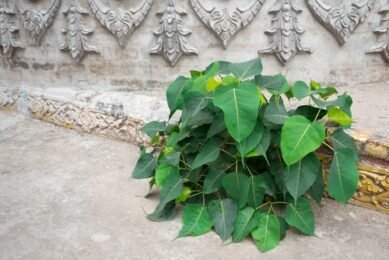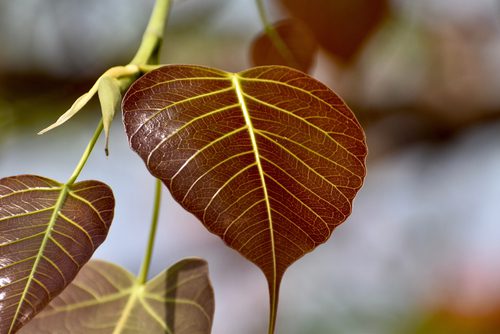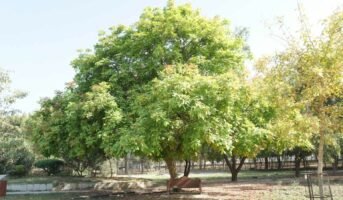Sacred Fig, often known as Ficus religiosa, is a fig species indigenous to the Indian subcontinent and Indochina. It is a member of the Moraceae (fig or mulberry) family. It is also known as the ashvattha tree, bodhi tree, pippala tree, peepal tree, peepal tree, and pipal tree (in India and Nepal).
Hinduism, Buddhism, and Jainism, the three major religions that emerged on the Indian subcontinent, consider the sacred fig to have religious importance. Hindu and Jain ascetics regard the plant as sacred and frequently meditate beneath it. It is said that Gautama Buddha acquired enlightenment beneath this tree.
See also: Banyan tree: All you need to know
See Also: also Morinda Indian Mulberry

Source: Pinterest
Sacred fig: Key facts
| Common name | Sacred fig, pipal, peepal |
| Botanical name | Ficus religiosa |
| Maintenance | Low-moderate care |
| Soil | well-drained |
| Water | Required when it’s really dry because it thrives in damp soil. |
| Temperature | Prefer warm and humid temperatures |
| Sunlight | Bright direct sunlight |
See also: Fruit plants: Everything you Need to Know
Sacred fig: The Genus

Ficus religiosa or sacred fig belongs to the Ficus genus from the Moraceae, the fig or mulberry family. The genus has around 850n species of woody trees, shrubs, vines, epiphytes and hemiepiphytes.
Sacred fig: Native habitat

Plants of the Ficus genus grow throughout the tropics with some species extending to semi-warm temperate zones. The common fig is a temperate species native to southwest Asia and the Mediterranean areas, from Afghanistan to Portugal.
Sacred fig: Physical features

Ficus religiosa is a huge dry-season deciduous or semi-evergreen tree that can reach a height of 30 metres (98 feet) with a trunk diameter of up to 3 metres (9.8 ft). The leaves are 10–17 centimetres (3.9 – 6.7 in) long and 8–12 centimetres (3.1 – 4.7 in) broad, with a petiole measuring 6–10 centimetres (2.4 – 3.9 in). The fruits are green figs 1–1.5 centimetres (0.39–0.50 in) in diameter that turn purple upon maturing.
Sacred fig: Significance
- In Hindu tradition, the sacred fig is treasured as a representation of the infinite expanse of the universe. Likewise, it is known as the Tree of Life for the same reason.
- In Buddhism, the peepal tree is viewed as a representation of the Buddha, and hence its leaves are used for religious purposes.
- For many, the peepal tree represents enlightenment and calm.
- Hindus believe that Lord Vishnu was born beneath this tree.
- Additionally, Ficus religiosa is a symbol of fertility. Therefore, ladies in Indian villages worship it.

Source: Pinterest
Sacred fig tree: Simple steps to grow from a seed

- Fill a container with premium potting soil. Use your fingers to lightly compact and smooth out the potting dirt for your peepal tree. Create a 2-inch hole in the upper centre of the potting soil once the dirt has hardened.
- Drop a sacred fig tree seed into the newly-dug hole in the potting soil. Cover the seed completely with dirt, but avoid compacting it.
- Fill a spray bottle with water and mist the soil until it is damp but not drenched. Use plastic wrap to cover your pot.
- Check the soil every day and maintain its moisture content. After one week, small green shoots will emerge from the dirt. Once the tree seedling reaches 3 to 4 inches in height, it can be put outside if desired.
Propagation by means of stem cuttings

The parent plant’s stem can be severed. The lower leaves are removed, leaving the top two or three leaves. The slice is placed in moist soil after being treated with rooting hormone. It is regularly watered and placed in an area that receives sufficient sunlight.
Sacred fig: Care and maintenance

Location and sun tolerance
Sacred fig is a sun- and heat-loving tropical plant, so place it in an area that receives plenty of direct/filtered sunlight. In contrast, excessive exposure to direct afternoon sunlight can hurt and even kill it.
Soil
The sacred fig thrives in well-drained, nutrient-rich soil. Ensure that the soil is not packed too tightly in the container, which will prevent the roots from sprouting.
Watering
Sacred fig thrives in moist conditions but should not be overwatered. When the soil is entirely dry, the plant should be watered. They should be watered thoroughly until the water runs out of the drainage hole. They favour moist settings.
The pot can be placed on a tray of moist pebbles. Water evaporation from this will help retain moisture. Ensure that the soil is not packed too tightly in the container, which will prevent the roots from sprouting.
Temperature, cold tolerance and moisture
As a tropical plant, Ficus religiosa prefers warmth and humidity. It can tolerate temperatures up to 16 degrees Celsius. However, because it cannot tolerate freezing temperatures or drafts, it must be kept indoors during the harsh winters, particularly if you reside in the far north of India.
Fertilisation
Once every two to four weeks throughout the growing period, fertilise the plant with organic fertiliser. Dosage and instructions should be listed on the product’s label. Winter is not the time to fertilise the plant. After the tree is well-established, you will not need to fertilise it frequently. A fertiliser containing nitrogen is also effective.
Insects and illnesses
The plant is not susceptible to pests under Indian growth conditions, thankfully. To prevent the spread of disease, avoid unnecessary leaf watering.
Pruning
Sacred fig is a plant with rapid growth. After six to ten leaves have grown, prune to two to four. Spring is the ideal season for heavy pruning, but it can be done at any time of year. Throughout the growing season, prune the new growth. When pruning smaller branches, leave a short stub that will dry out over the next few days, and then remove the dry branch, which will heal with minimal scars.
Sacred fig: Benefits

- It has numerous therapeutic benefits.
- It is used to treat a variety of infections and inflammations, such as asthma, diabetes, snake bites, skin illnesses, and renal diseases, among others.
- Sacred fig has numerous applications in the Ayurvedic medical system.
- This tree’s bark contains significant levels of vitamin K.
Sacred fig: Uses

- In Hindu temples, the fruit (fig) of the peepal tree is used as a bead to honour the gods.
- From the bark of Ficus religiosa, a crimson dye is derived.
- Bark is utilised for tanning.
- It is used as a fuel source.
Sacred fig is used for a variety of medicinal purposes, such as
- In case of diarrhoea
- For menorrhagia
- Boosts the power of the lungs
- Treats a lack of appetite
- Stops the bleeding from the nose
- Cleanses the blood
Sacred fig: Toxicity
Peepal fruit contains latex, which may trigger allergic reactions or rashes in certain individuals. Therefore, it is recommended to consult a physician before applying Peepal to the skin.
FAQs
Are Peepal and sacred fig the same thing?
Peepal is also referred to as the sacred fig, and its botanical name is Ficus religiosa.
Does sacred fig produce oxygen during the night?
The peepal tree, also known as the sacred fig, releases oxygen continuously, unlike many other plants that only do so during the day.
Got any questions or point of view on our article? We would love to hear from you. Write to our Editor-in-Chief Jhumur Ghosh at [email protected]
Housing News Desk is the news desk of leading online real estate portal, Housing.com. Housing News Desk focuses on a variety of topics such as real estate laws, taxes, current news, property trends, home loans, rentals, décor, green homes, home improvement, etc. The main objective of the news desk, is to cover the real estate sector from the perspective of providing information that is useful to the end-user.
Facebook: https://www.facebook.com/housing.com/
Twitter: https://twitter.com/Housing
Email: [email protected]











